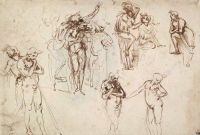Remaking Nature Click on the thumbnails to explore the trail
Read more about this trail (expand)
Leonardo’s ultimate aim was to imitate nature by remaking nature, as opposed to slavishly copying natural forms. This would require a profound understanding of the relationship between the effects of natural appearances and the underlying causes that gave rise to their form. Equipped with this knowledge, Leonardo believed he could create forms equitable to those found in nature, many of which might be of great service to man.
Figure studies for an Adoration of the Magi 1481
For Leonardo, the ability to recreate the human figure in paintings was of paramount importance.
These lively studies for the Adoration of the Magi illustrate his advice to painters to begin by attending broadly to the position of the limbs of figures and movements appropriate to their mental attitudes, rather than to the “beauty and quality of their limbs”. Impromptu sketches of figures encountered on the street could provide a veritable encyclopedia of forms that should be studied at length by young students “during the long winter evenings”. By the following summer, having learnt how to represent all the forms of the body, the student would then be equipped to study a figure performing “light and graceful movements”.
The economy of the technique in this drawing belies the vast amount of practice that underlies all of Leonardo’s surviving drawings. The figures are anatomically convincing and credibly three-dimensional, despite the minimal amount of information supplied by the lines of Leonardo’s pen. The reinforced contours capture the energetic movements and expressions of the figures perfectly, as he defines and redefines their poses according to their intended position in the painting.
In Leonardo's words
When you draw the nude…never make the head turn the same way as the torso, nor the arm and leg move together on the same side. And if the face is turned to the right shoulder, make all the parts lower on the left side than on the right; and when you turn the body with the breast outwards, if the head turns to the left side make the parts on the right side higher than those on the left.
This sheet is one of the most striking group of studies for the Adoration of the Magi, begun by Leonardo in Florence in 1481 and left unfinished when he departed for Milan either late in 1482 or early in 1483.
A significant amount of preliminary work has been carried out with a stylus prior to the use of pen and ink. The lines of the pen-work do not always follow the stylus lines, but re-define the poses of the figures in relation to each other.
The multiple changes indicate an experimental approach in an attempt to capture the figures in lively interaction as they consider or debate the arrival of the Christchild, as illustrated in the Adoration of the Magi painting.
The pen-work is heavy and reinforced in places, as Leonardo seeks to clarify the pose of some figures or indicate the fall of light on their bodies. Areas of parallel diagonal hatching may be related to intended areas of shadow in the painting. This suggests that Leonardo had already planned the composition before he started this drawing.
Only the figure seen at the lower left and again at lower centre was used in the Adoration of the Magi painting, where it appears on the extreme left in the foreground.
- Medium Pen and ink over stylus
- Size 17.9 x 26.3 cm
- Location École Nationale Supérieure des Beaux-Arts












